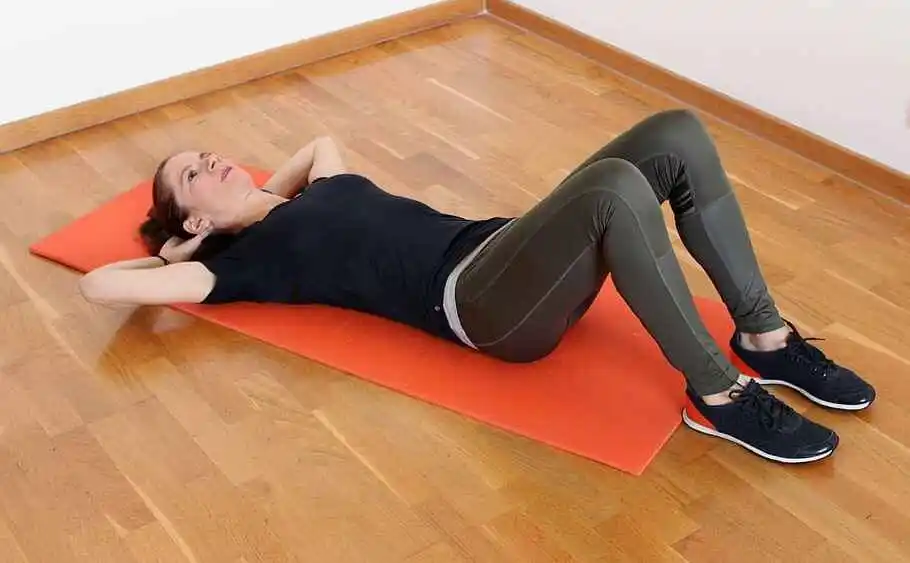Kegel Exercises
Kegel exercises are simple pelvic floor muscle-strengthening movements that help improve bladder control, support pelvic organs, and enhance overall core stability. They involve contracting and relaxing the pelvic floor muscles, which are the muscles used to stop urine flow.
Suitable for both men and women, these exercises can be performed discreetly anytime and anywhere. Regular practice can improve urinary incontinence, support recovery after childbirth, and enhance sexual health.
- Kegel exercises are beneficial for persons who have penile and vaginal sex. Kegel exercises are simple clench-and-release movements that improve pelvic floor strength.
- Your reproductive organs are located in the region between your hips, which is called your pelvis.
- The pelvic floor is a network of muscles and tissues that form a sling or hammock at the base of your pelvis.
- This sling holds your organs in place. One of the issues that might arise from a weak pelvic floor is the inability to control your intestines or bladder.
- Easy to complete, Kegel exercises may be done anytime, anywhere—in the comfort of your own home, while waiting in line at the bank, for example.
Introduction:
You can strengthen the muscles in your pelvic floor by completing basic clench-and-release motions called Kegel exercises. Your reproductive organs are positioned in the region between your hips, in your pelvis.
The muscles and tissues at the base of your pelvis that work together to create an attachment or hanging structure are referred to as the “pelvic floor.” Your organs are protected by this sling. A weak pelvic floor may result in issues like difficulty controlling your bowels or bladder.
Kegel exercises can be performed anywhere, at any time, and even in the convenience of your own home. They are simple to execute.
What is meant by a Kegel exercise?
Kegel exercises, also referred to as pelvic floor exercises, are a great way to strengthen your pelvic floor muscles. Your pelvic floor muscles support several pelvic organs, including the bladder, bowel, and vagina. Your pelvic floor muscles aid in urinating and other body processes, as well as supporting the posture of your organs. Kegel exercises involve tightening and then relaxing your pelvic floor muscles.
Why are Kegel exercises important?
Numerous illnesses, including chronic coughing or constipation, aging, pregnancy, childbirth, surgery, and being overweight, can impair your pelvic floor muscles.
Kegel workouts might be beneficial to you if:
- A few droplets of pee flow when you cough, laugh, or sneeze (stress incontinence)
- Urinary urge incontinence, or an intense and urgent need to urinate, occurs just before significant urine loss.
- Incontinence of the urine or leaking waste
You can also try to reduce your symptoms throughout pregnancy or after delivery by doing Kegel exercises.
Kegel exercise purposes and advantages:
Make sure your bladder is empty before doing any Kegel exercises. Look for a peaceful, secluded spot to sit or lie down when you first start. As you practice, you’ll find that you can perform them anywhere.
Start Kegel exercises by contracting your pelvic floor muscles for three counts, followed by three counts of release. Keep doing this until you’ve finished ten rounds. Over the coming days, work on maintaining stiff muscles for ten counts. Three sets of ten repetitions should be your daily goal.
If, in spite of your greatest efforts, you don’t immediately see the desired outcomes, keep trying. The results of Kegel exercises for urine incontinence may not be seen for several months. They also work differently for each person. Some people’s ability to control their muscles and keep their urine has significantly improved. However, Kegel exercises may prevent the progression of your condition.
How does Kegel exercise work in practice?
Performing Kegel exercises will keep your Pelvic Floor muscles “fit.” Kegel exercises are a good way to keep your pelvic floor muscles strong, just like lifting weights can help you get stronger.
Kegel exercises may help you maintain stronger pelvic muscles and improve your control over your bladder and bowel motions. Weak pelvic floor muscles may cause you to inadvertently release gas or leak urine and feces. Age, pregnancy, childbirth, or surgery can all cause the muscles supporting your pelvic floor to weaken.
Who should perform Kegel exercises?
If something puts too much tension on your pelvic floor muscles, they may weaken and lose their ability to support your pelvic organs. Your pelvic floor muscles may become weaker as a result of certain illnesses or life experiences.
This collection of incidents and situations consists of:
- becoming a mother.
- delivering babies, including cesarean procedures.
- Obesity is defined as having a body mass index (BMI) of 25 or higher (BMI more than 30).
- surgery involving the lower abdomen.
- growing older. As you age, the muscles in your rectum, anus, and pelvic floor will gradually deteriorate.
- significant gastrointestinal straining (constipation) or a protracted cough.
- Exercises, particularly hard lifting, sprinting, and leaping.
Kegel exercises aren’t for everyone, though. Muscles that are overly rigid or stiff can be the result of performing Kegel exercises too often or when they are not necessary.
Kegel exercises and pregnancy:
Pregnant women may find it easier to give birth if they do Kegel exercises. This is because it may allow you to have more control over your pelvic muscles when giving delivery.
Additionally, it might be beneficial for:
- bladder regulation.
- boosting the fetal weight-bearing muscles’ strength.
- such as incontinence or urine leaking.
- pushing during a birth via the vagina.
- the perineal recovery following delivery.
How can I find my pelvic floor muscles?
- While sitting on the toilet, try to stop the flow of pee to identify your pelvic floor muscles. Continue until you get the hang of it; if not, you risk contracting an infection. Visualizing oneself attempting to stop yourself from passing gas is an additional option.
- Another technique is to use your finger to squeeze the muscles surrounding your vagina. Your finger ought to feel tense. When you do Kegel exercises, you will notice that your muscles are “lifting,” a sign that they are becoming stronger.
How to perform Kegel exercises:
To begin with:
- Locate the correct muscles.
When you urinate, take time to notice your pelvic floor muscles. Once you’ve identified which pelvic floor muscles are used, you can perform the exercises in any position you choose, but initially, you might find that lying down works best.
- Develop your method
To perform Kegel exercises while seated, tense your pelvic muscles as though you were lifting a stone. After three counts of relaxation, try it for three seconds at a time.
- Keep your attention focused
For optimal effects, focus solely on strengthening your pelvic floor muscles. Be careful not to flex your abdominal muscles, thighs, or buttocks. Don’t hold your breath. Instead, while you complete the exercises, take deep breaths.
- Repetition
Repeat three times a day. Try to complete three sets of ten to fifteen repetitions or more each day.
You shouldn’t employ Kegel exercises to teach your pee stream to start and stop. When doing Kegel exercises, you run the risk of not fully emptying your bladder, which raises the risk of getting a urinary tract infection.
Bridge Task
The bridge exercise helps strengthen the buttocks and work the pelvic floor.
- Lying on your back, assume an upright stance with your feet hip-width apart and flat on the ground.
- Don’t move your hands from your sides.
- Contract your buttocks and pelvic floor muscles to raise your buttocks a few inches off the floor.
- Maintain this posture for a short while.
- Release your pelvic floor muscles and drop your buttocks to the floor.
- Then return to your neutral position.
- Then unwind.
- Three to six repetitions of this workout are required.
As their pelvic floor strength increases, many find they can do more repetitions.

Squats
- Place your feet hip-width apart while keeping your feet flat on the ground.
- To bring your buttocks as close to the floor as is comfortable, bend your knees slightly.
- Maintain this posture for a short while.
- Maintain a straight back and a slightly forward-pointing head.
- Place the knees and toes parallel to each other.
- Focus on squeezing your buttocks and pelvic floor when you stand back up.
- Then return to your neutral position.
- Then unwind.
- Three to six repetitions of this workout are required.
But not every squat uses the pelvic floor. It could be difficult to maintain a pelvic floor contraction when performing deep or wide-legged squats. Short, deep squats are frequently more effective for pelvic floor strengthening.

Pelvic tilts
- When you are on your back with your feet flat on the floor, your knees should be bent.
- Put pressure on your lower back and tense your abdominal muscles.
- Maintain this posture for a short while.
- After that, relax and slowly straighten your back.
- Then return to your neutral position.
- Then unwind.
- Three to six repetitions of this workout are required.

Inner Thigh Compression
- With your knees bent and your feet flat on the ground, you can sit or lie down.
- Put a folded piece of cloth or a softball between your knees.
- Using the muscles in your inner thighs, squeeze your knees together.
- Maintain this posture for a short while.
- Then return to your neutral position.
- Then unwind.
- Three to six repetitions of this workout are required.

Variate your physical activity routine:
- There are several variations of this fundamental exercise that you might try.
- For instance, rapidly tense and relax your pelvic floor muscles.
- As an alternative, try slowly drawing them in.
- To improve your posture, you can also perform Kegel exercises while sitting, standing, or lying down.
- It’s better to avoid tensing your abdominals, thighs, or butt when performing Kegel exercises.
- Additionally, don’t hold your breath. Rather, breathe regularly and maintain a calm, relaxed posture with the rest of your body.
How many and for how long do I practice legal exercise?
Performing three to six repetitions wears down your muscles, and it’s common to find that your initial attempts at a Kegel exercise barely last three to six seconds. You are most likely doing the workout correctly when this occurs.
You can hold it for a longer period right away if you double-check your technique. For those with incontinence or weak pelvic floors, it is extremely crucial to concentrate on doing the technique correctly. Your muscle tone and quality may be weak at first, but they will improve over time.
How can you know if you’re performing Kegel exercises correctly?
Kegel exercises shouldn’t cause discomfort. If you experience pain in your head, lower back, or stomach when doing Kegel exercises, you’re either holding your breath or squeezing the wrong muscles.
You could not be performing Kegel exercises correctly if you are having problems activating your pelvic floor muscles or if you are experiencing pain or discomfort in your legs. Consulting a physician could be helpful.
If you’re performing Kegel exercises properly, you should gradually notice a decrease in your symptoms over a few weeks. For instance, you might observe that you urinate less frequently.
To achieve Kegels, how hard should I squeeze?
You have to clinch or tighten sufficiently to feel Kegel exercises working. However, take care not to squeeze or apply pressure on your inner thighs, stomach, buttocks, or back. If you are squeezing these muscles, you are not doing the exercise correctly.
Additionally, you should refrain from using excessive pressure to hold your breath. As you perform the Kegel exercises, take regular breaths. You may be able to maintain your normal breathing pattern by counting out loud.
A few words of concern:
- Try not to practice Kegel exercises more than twice a month after you’ve learned how to execute them. You run the danger of gradually weakening your pelvic floor muscles and injuring your kidneys and bladder if you perform the exercises while urinating.
- Women may have excessive vaginal muscle stiffness if they perform Kegel exercises incorrectly or with too much power.
- You will regain incontinence if you stop performing these exercises. You might have to continue doing them for the rest of your life once you get started.
- Your incontinence may not improve for several months after you start these workouts.
- You shouldn’t employ Kegel exercises to teach your pee stream to start and stop. A urinary tract infection is more likely to occur if you perform Kegel exercises while emptying your bladder since this could cause partial emptying.
Complications with Kegel exercises:
Despite the safety of kegel exercises, vigilance is nevertheless urged.
The following are some things to be aware of:
- You shouldn’t perform Kegel exercises while urinating.
- The objective is to make your muscles feel more intense as if you were trying to stop urinating, but you aren’t. A urinary tract infection (UTI) is something you could have.
- Don’t go too far. This could make going to the bathroom more difficult.
- Exercise regularly.
- Like other workouts, Kegel exercises need to be performed repeatedly to gain strength.
- For at least ten to fifteen weeks, these must be finished every day.
- Any changes you make to your treatment plan should be discussed with your physician.
When Challenges Come Up:
- If you need assistance with Kegel exercises, don’t be embarrassed to ask for it.
- You can get helpful advice from your physician or physical therapist on how to recognize and work on the appropriate muscles.
- Vaginal weighted cones or biofeedback may be useful in specific circumstances. You must insert a vaginal cone into your vagina and maintain it there by clenching your pelvic muscles as you go about your daily business.
- Your doctor or another medical professional inserts a pressure sensor into your vagina or rectum during a biofeedback session.
- When you contract and relax your pelvic floor muscles, a monitor will record and display your pelvic floor activity.
When To Expect Results:
Regular Kegel exercises may not provide noticeable effects, including fewer instances of frequent urine, for several weeks to several months. To reap the long-term advantages, schedule daily Kegel exercises.
Exercises to stay away from:
Certain exercises may be too difficult for someone with a severely weak pelvic floor. By doing the exercises, you run the danger of further weakening your muscles and developing incontinence.
For a few months after working on their pelvic floor, a person should avoid doing the following exercises:
- Straight-leg lifts into the air during sit-ups
- Lifting heavy weights with few repetitions
- Leg lifts with two legs
- Jumping, running, and other strenuous activities
It is not recommended to stop urinating to assess pelvic floor muscle control. This could result in inadequate bladder emptying, which would increase the risk of UTIs and other urinary issues.
To find out if there are any specific exercises you should avoid after surgery or childbirth, try to speak with a doctor and a physical therapist.
When to Consult a Doctor:
Consult your healthcare provider if you have any doubts about whether you are doing Kegel exercises appropriately. Your supplier can confirm that you are filling them out appropriately. You can be sent to a physical therapist who specializes in pelvic floor exercises.
Summary
Kegel exercises are exercises designed to strengthen the muscles in your pelvic floor. Many factors can contribute to weak pelvic floors. The need to urinate when not needed and the leaking of waste or urine are symptoms of a weak pelvic floor. Work your way up to doing Kegel exercises several times a day. Never hesitate to seek medical counsel if you are unsure if you are performing Kegel exercises correctly or if you have any questions about them.
In addition to performing daily pelvic floor exercises, someone can strengthen their pelvic floor by walking more, standing up straight, and sitting in the proper positions. Another alternative to think about is to squeeze the pelvic floor muscles every time you cough, sneeze, or lift something heavy. This will strengthen the pelvic floor and avoid incontinence.
FAQ:
How do the Kegel exercises work?
Several factors, including age, surgery, and childbirth, can affect the pelvic floor muscles. You can start to leak little amounts of gas, pee, or excrement if these muscles are weak. These leaks can be stopped by strengthening these muscles with Kegel exercises.
For whom is Kegels necessary?
Kegel exercises might help if you cough, sneeze, laugh, or have a few drops of urine flow (stress incontinence).
Urinary urge incontinence is the desire to urinate quickly and forcefully right before significant urine loss.
Fecal incontinence is another name for leaky waste.
Who needs Kegels?
If you sneeze, laugh, or cough and a few urine droplets leak (stress incontinence), Kegel exercises may be beneficial for you.
Urinary urge incontinence is the sudden, intense urge to urinate that occurs just before significant urine loss.
Fecal incontinence or littering
Do males benefit from Kegel exercises in bed?
Because they are the most successful, pelvic floor exercises, also known as kegel exercises, should be the first line of treatment for erectile dysfunction. The ischiocavernosus and bulbocavernosus, the pelvic muscles that encircle the penis, contract during an erection.
Is doing Kegels every day okay?
Within a few weeks to several months, regular Kegel exercises can result in benefits including less frequent urine. For long-term advantages, incorporate Kegel exercises into your everyday routine.
What is the sensation of a kegel?
Feel your pelvic floor muscles grow or expand as you inhale. Exhale slowly while contracting your pelvic floor muscles. It should feel as though it is constricted. For 3 to 5 seconds, tent.
References:
How to squeeze in kegels all day long. (n.d.). Mayo Clinic. https://www.mayoclinic.org/healthy-lifestyle/womens-health/in-depth/kegel-exercises/art-20045283
Sharma, R. (2024, January 7). Kegel exercises- for strength and vitality. Mobile Physiotherapy Clinic. https://mobilephysiotherapyclinic.in/kegel-exercises-2/
Professional, C. C. M. (2024, May 1). Kegel exercises. Cleveland Clinic. https://my.clevelandclinic.org/health/articles/14611-kegel-exercises
Bariya, D. (2024, April 12). Kegel exercises – benefits, how to do?, precaution. Physical Therapy Treatment and Exercise. https://physical-therapy.us/kegel-exercises/
Story, C. M. (2017, September 15). Kegel Exercises for men: Do they work? Healthline. https://www.healthline.com/health/kegel-exercises-for-men#for-men







